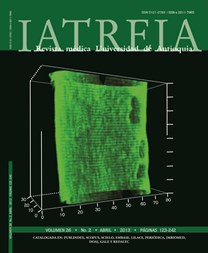Enzymatic dissociation of long muscles from mice: a model for the study of skeletal muscle fiber types
DOI:
https://doi.org/10.17533/udea.iatreia.14357Keywords:
Cadenas Pesadas de Miosina, Músculo Esquelético, Músculo Soleus, Señalización del CalcioAbstract
The enzymatic dissociation of short muscles from mice, such as flexor digitorum brevis, has allowed a great accumulation of physiological, pharmacological and biochemical knowledge about skeletal muscle. However, this body of knowledge has been restricted to the types of fibers present in these muscles. Information about the other fiber types has been limited and has been primarily obtained by the manual isolation of fibers from other species, typically rats, via a difficult and time-consuming procedure. In this report, the author describes a technique for the enzymatic dissociation of long muscles, such as soleus or extensor digitorum longus(EDL), which can be applied to study a wider spectrum of fiber types and larger quantities of cells. Additionally, the kinetics of Ca2+ transients obtained in soleus and EDL fibers are compared in this report. The usefulness of this methodology for other physiological, biochemical and molecular biology experiments is also discussed. This methodology introduces the possibility of using the whole spectrum of fiber types to study normal muscle biology and the pathophysiology of muscle diseases.
Downloads
Downloads
Published
How to Cite
Issue
Section
License
Papers published in the journal are available for use under the Creative Commons license, specifically Attribution-NonCommercial-ShareAlike 4.0 International.
The papers must be unpublished and sent exclusively to the Journal Iatreia; the author uploading the contribution is required to submit two fully completed formats: article submission and authorship responsibility.














